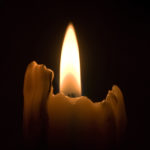
Candle light in the dark
You’re planning your wedding ceremony and want to include a unity ritual. You think unity candle or sand ceremony. Both are lovely, but you do have other options.
In a wedding, the purpose of a unity ritual is to symbolize the joining of two people and two families for generations. A wedding adds a branch to a family tree. To see how important a branch can be, just watch the television commercials for ancestry.com and the public television show, Finding Your Roots.
When a couple tells me they want a unity ritual, I start with the elements of earth, air, fire, and water. Back in the 5th Century, BCE, Empedocles, a Greek philosopher living in Sicily, said all matter is comprised of those four elements. Later, Aristotle added a fifth element aether – meaning spirit, prana, chi, life force. This concept of 5 elements can be seen in Hinduism, Buddhism, and Paganism and probably other religions. While science has shown us that the elements of creation aren’t that simple, the original four elements are effective tools to inspire unity rituals.
An important side note: As a proud supporter of marriage equality, I want to be sure you know that when I describe these rituals with the words “bride” and “groom,” I’m doing so only for easy distinction and stage direction.
FIRE and the Unity Candle
Let’s start with FIRE. It’s the element associated with heat, light, inspiration, intuition, will power, passion, ambition, goals, the desires in life that are so strong we’ll put in the sweat equity to achieve them.
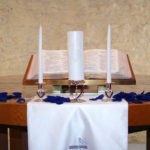
Traditional unity candle on a church altar
Fire at the heart of a Unity Candle ritual. The basic idea is to blend two flames into one. The bride’s mother lights a candle. The groom’s mother lights a duplicate candle. These two candles are usually 12-inch white tapers. The bride and groom use those tapers to transfer flame from the two family candles to a third candle, larger than the others or noticeably decorated or different in color. That’s the candle that represents the two of them and and their union as a couple. That unity candle burns throughout the ceremony. The candles that the moms lit can be extinguished immediately after the couple lights their unity candle, or later in the ceremony. There’s no one, right way.
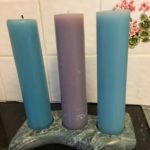
Colorful candles for a unity candle ritual
Don’t be restricted by while candles. Incorporate your wedding colors. That’s a simple way to personalize the ritual.
Another way is to use a toothpick. Yes, a plain wooden toothpick. Sometime before the ceremony, perhaps at the rehearsal dinner, or on the last night you spend together before the wedding, on as part of your first look, use the toothpick to carve your names or initials into the candle. You can carve words, symbols, too. If you have children, add their names to the candle.
For my fellow officiants, remember that any ritual can feel flat without context. For a unity candle ritual, add language about what the flame means.
Let me tell you about one of my couples: Emely and Sol. They were married at the Chapel at Wesleyan University in Middletown, CT. Before the two moms lit their candles, I said this:

Porch light stays on until all the children are home (Photo by Jarrod Reed of Unsplash)
On a birthday cake, fire marks the passage of time. Around a campfire, fire sets the stage for stories. Fire represents the heated words of adolescence—so necessary to the process of growing up. Fire represents the porch light that isn’t turned off until a child, of whatever age, is safely home. Fire represents the ambition and drive children needs to build their own lives. Fire represents the hearth in a new home…with all the warmth, illumination, inspiration and passion that parents want for their children.

Blacksmith in his forge
You might be officiating for someone who is an Eagle Scout and had to learn to make fire with a piece of flint. You might be officiating for someone who has a passion for making cupcakes and the heat of an oven is critical to her creativity and success. You might be officiating for a glassblower or a blacksmith or a microbrewer. They all work with fire. In such cases, add language that reflects their connection to fire – that fire is used to create a container, or a tool, or a drink. Give context to the ritual.
EARTH and the Sand Ceremony
Earth is associated with trees, rocks, and mountains, with the ancestors, the legacy we’re given and the legacy we leave. Picture an hourglass with its shifting “sands of time” and you can feel a link to a wedding sand ceremony.
The central idea behind the sand ceremony is that the bride and groom each pour sand from their individual containers into the one container that represents their union. The sand in their individual containers might be different colors, or it might have come from different places.
When the sand is different colors, blending it can create a work of art. The couple can each pour several colors of sand. Or family members might pour some of the colors.
As I said earlier, a ritual without context can fall flat. Though a sand ceremony can be visually interesting, it needs context to make it meaningful.
Multicolored Sand
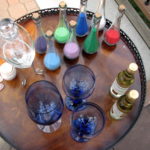
Assorted colors of sand ready for the ceremony
Let me tell you a story about one of my couples, Alison and Kevin. They were married at the Riverhouse in Haddam, CT. Alison worked for an environmental agency. Kevin was a professional golf instructor. They used little vials of sand in various colors. Here’s how I introduced the ritual.
Couples often talk about romantic walks along the beach. They might comb the shore for a shell to treasure. They might pause to write a message or sketch a valentine. They might build a castle. All of those activities have one thing in common: sand.
Sand can present challenges too. At the beach, it might get in a person’s eyes. On the golf course, it might trap a player’s ball.
Scooped up with our hands, sand easily slips through our fingers. And yet that same sand can shape and hold the coastline of a continent.
For centuries, cultures the world over have made art with sand. One grain falls upon the other, different colors mix and mingle and a thing of beauty is created. Kevin and Allison will do the same today. [I paused and directed attention to the empty glass container.]
This jar is the container for their lives as individuals and as a couple. It has plenty of room to hold the gifts they’ve received from friends and family and the gifts they give to each other.
Alison and Kevin, home is where your story begins. Create the foundation for your marriage by pouring sand to represent your past.
Each poured sand for the past.
Guidance is a gift of understanding. The past is strengthened by the present and the guidance you’ve received from family and friends. Build upon your foundation with colors for guidance.
Each poured sand for guidance
Wisdom is a gift of experience. Friends and family have shared their wisdom with you. Build upon your foundation with colors for wisdom.
Each pours sand for wisdom
Love is the gift of joy. All your lives, friends and family have shown you their love, just as you show it to each other today, just as you will show it to each other every day. Ensure your foundation with colors for the love you’ve received and the love you share.
Each poured sand for love
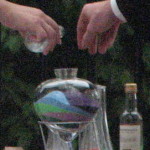
A sand ceremony was the perfect ritual for the groom – a professional golfer!
The final pouring of sand represents the inseparable union you create today. Once blended, the colors of sand are inseparable, just as each of you will always be inseparable from the other.
Each poured sand for foundation
May these layers of past, present, and future, guidance, wisdom, and love be an ever present reminder of the beauty and strength of your marriage.
Sand Ceremony on the Beach
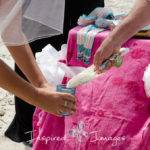
Leslie and Chuck chose a sand ceremony for their beach wedding
Here’s another story. Leslie and Chuck were married on a beach in Rhode Island. A sand ceremony was a natural. For their ceremony, the sand was not distinguished by color. Instead, they blended sand from the beach in Florida where Chuck grew up, from the beach in Connecticut where Leslie grew up, and from the Rhode Island beach where we held the ceremony.
My thanks to their photographer, Inspired Images, for these photos.
Instead of Sand
A variation on the sand ceremony is to pour herbs and spices. If the end result is for the visual effect only, use any blend and go for variation in color and texture. But if you intend to use the blend in your kitchen, well, just be mindful of your recipes.
Once again, you need context to give meaning to the action of the ritual. One way is to associate each herb or spice with a memory. The officiant might say:
- Lavender for the sugar cookies the bride made with her grandmother.
- Orange peel for the groom’s favorite pudding, the one his dad always made for him on his birthday.
Or, draw on the magical associations of the herbs and spices:
- Tarragon for compassion
- Basil for courage
- Thyme for bravery
- Dill for mental strength
- Rosemary for fidelity
- Coriander for family harmony
EARTH and the Tree Planting Ceremony
Earth is the element of stability, of what’s tangible, real, and lasting. Think of rocks, mountains and trees.
In a tree-planting ceremony, you can place a sapling with the roots wrapped, in a large container for use in the ceremony. Within a few days, actually plant the tree in the ground where you want it to grow.
Or, you can plant a tree in a container and keep it in the container for a few years. This method does limit your choice of trees but it doesn’t limit what you can do in the ceremony.

Dwarf Spruce in container for a tree-planting ritual

Braided ficus in a container for a tree-planting ritual
For a container tree, select a dwarf fir or a ficus. Either one can live in a container on a patio for a while. Just be aware that a dwarf fir doesn’t mean it will stay small. It means it will grow slowly. I know from experience.
The best thing to do is ask the professionals at your local nursery.
To personalize the ritual, use several containers of soil: One for the childhood home of the bride and the groom, one for the home they share now.
Blending soil can symbolize healing. The parents of one of my grooms had divorced when he and his siblings were young. The children grew up spending time with both parents in two different states. They blended soil from several childhood homes and had their siblings pour some of the soil.
For couples who want to include a reading, this Chinese poem is from the Tsin Dynasty, 265-316, A.D. It expresses in just a few lines the union of two people in love.
Do you not see
That you and I
Are as the branches of one tree?
With your rejoicing
Comes my laughter;
With your sadness
Start my tears.
Love,
Could life be otherwise
With you and me?
Once the soil has been added, I address the couple: Your family tree has been lovingly planted. As you water it for the first time, pour the nutrients gathered from the family trees of your ancestors. Pour commitment and courage, integrity and respect, faith and faithfulness. In turn, may your new tree shade you with joy, contentment, and the sweet stillness in which two hearts can grow as one.
Some couples pour from a pretty pitcher. Some use simple Mason jars. Anytime you use a prop in a ceremony, find out if a friend or family member wants to provide the prop as a wedding gift. A tree can be “spendy.”
WATER and a Wine-Blending Ritual
WATER represents the realm of emotions, of cleansing and compassion, memory and forgiveness, of gentle strength.
A wine-blending ritual is particularly appropriate for a wedding in a vineyard, or for a wedding in which a vineyard played a part in the love story.
Beth and Tom wanted a wine blending ritual. In getting to know them, I learned about their Cape Cod vacation and wine tasting tour. With each vineyard, Tom evaluated the setting, looking for the perfect atmosphere. He did so for days, carrying the ring in his pocket. He remembered Beth being so relaxed, while he was oh so nervous. I talked about the proposal and introduced the wine ritual by saying:
The vineyard proved to be a magical place for Beth and Tom. A person can glean a lot of wisdom from studying vineyards. Last year, Wine Spectator magazine found important life lessons in their list of the Top Ten Wines. Here are two of those key lessons.
In the #10 position was a wine from France. The fruit was sourced from 80-year-old vines in five vineyards. A devastating hailstorm reduced buds, and ultimately yields, by 50 percent. Then came hot, dry weather. The heat ripened the grapes – those that survived. But that dry air concentrated their flavor. In the end, critics praised the wine for its noticeable power.
The lesson: What doesn’t destroy us makes us stronger.
(Château de St.-Cosme / Gigondas Valbelle 2009 / Southern Rhône, France)
At the top of the list, the #1 “Wine of the Year” was a Pinot Noir from Sonoma. More than a decade ago, two waiters pulled their tips so they’d have enough to make their own wine. They had no formal winemaking training. They stumbled along the path of trial and error. They didn’t own a single vine and had to rent a warehouse to have a place to make their wine. What they did have was a vision.
The lesson: Follow your dream. Find a way to make it happen.
(Kosta Browne / Pinot Noir Sonoma Coast 2009 / Sonoma County, CA )
Two things to remember: The visual of blending a red and a white is pretty, but I can’t vouch for the taste. And, be sure to have a small towel handy in case of spills.
AIR and Butterfly Blessings
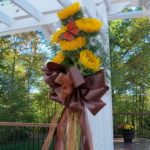
Wedding arbor for the Butterfly Blessing ritual by Zita Christian
AIR is the element of dawn, new beginnings, fresh starts, clear thinking, breaking away from the darkness. In Episode 10, I talk about a ritual I created called Butterfly Blessings and how it can be used as a gift-giving ritual that involves a few special guests. When the butterflies are placed by family members, the ritual takes on the energy of a unity ritual.
The ritual itself is simple. The couple provides a vase or basket of bare twigs. Prior to the ceremony, chosen family members are given silk butterflies (the kind that have alligator clips).
For the ritual, the officiant invites the family members to come forward, give a one-line blessing, and add their butterfly to the twigs. Here, too, the action needs context. If you’re the officiant, ask the parents and grandparents of the bride and groom for a few positive traits or qualities exhibited by their family members, especially by their ancestors. Identifying those traits can come from old photos, journals, and anecdotal stories handed down over the years. For example:
- I bring the courage of your great-great-grandmother when she crossed the ocean alone to build a new life here.
- I bring the determination of your great-great-grandparents who homesteaded on the Dakota Territory.
- I bring the adventurous spirit of your Uncle Ralph who joined the circus.
- I bring the entrepreneurial spirit of your Aunt Irma who started her own bakery.
Another Air Ritual: Music
In 2017, I was the officiant for Lisa and Jeff. Their ceremony was held in the ballroom of the Glen Manor House in Portsmouth RI. Both Lisa and Jeff are classical musicians. The met through music. The members of their wedding party are also professional musicians. Jeff and Lisa had what was the most innovative processional I’ve ever seen.

CT Officiant Zita Christian with newlyweds Jeff and Lisa at the Glen Manor House in Portsmouth RI; photo by Faith Dugan
Chairs for all the musicians were arranged in a circle in the front, right next to the ceremony space. Jeff’s musicians were seated early so they could play prelude music while the guests entered. When the processional began, Jeff’s musicians played for the entrance of the bridesmaids. They were Lisa’s musicians. Then all the musicians played for the entrance of the bride. Both pieces, first Schubert then Brahms, had been arranged by Jeff, a special gift to his bride!
All the musicians had come to the rehearsal so I got to hear them play. And still, on the wedding day, the music, and the love that made it happen, took my breath away. I remember blinking back tears and I know I wasn’t the only one.
Air and the Om Chant
The memory stayed with me and inspired another wedding ritual based on music and the element of air. I’ve never done this ritual. In fact, it was while preparing for this podcast episode that I thought of it.
You’d need someone to play chimes, someone else to lead the guests in an Om chant, and then someone to close the ritual with a powerful gong. I suppose you could do the ritual with just the chant, especially if you have a lot of people. This kind of unity ritual unites everyone present. And then for the recessional, work with the element of air again by having the guests shower the couple with tinkling bells!
These are just a few ideas for unity rituals inspired by the elements of earth, air, fire, and water. Of course, all marriages face challenges. And sometimes, the marriage doesn’t last and broken hearts need mending. That’s when ritual can particularly helpful and healing. In an upcoming episode of the podcast, I’ll talk about rituals for mending, dissolving, and releasing.
At this point, you might be thinking, then why bother with ritual? Well, the way I see it, you can spend your whole life running inside a hamster wheel. Or you can live a relevant life, courageously riding the wheel of life. Which view do you want?

